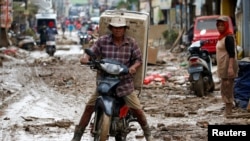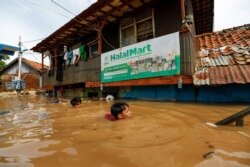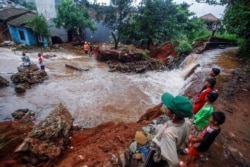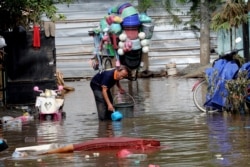The worst flooding in six years in Jakarta, Indonesia’s capital, has killed more than 40 people this week and focused attention on improving flood controls before the planned relocation of the capital.
Nonstop rainfall Tuesday and Wednesday flooded 268 tracts in Indonesia, 158 in low-lying Jakarta, the International Federation of Red Cross and Red Crescent Societies said on its website. Drainage and levees in the capital are considered inadequate for storms of that scale, Southeast Asian economists say.
Tuesday’s rainfall reached 377 millimeters (14.8 inches), a record since 2007, The Jakarta Post online said. The rains touched off landslides, trapped people in houses and prompted more than 19,000 to evacuate, local media reports say. The Red Cross federation put the number of displaced people at 31,232.
Trapped at home
“We even couldn’t get out of our house, we even felt like we were in the middle of a big pond,’’ said Paramita Supamijoto, an international relations lecturer at Bina Nusantara University in Jakarta.
Water levels inside her house topped out around 40 centimeters (15.7 inches) above the floor, she told VOA by phone.
“The water outside our house was higher, I think about 50 or 60 centimeters (19.6-23.6 inches), almost half the height of the average adult,” she said. It left a stench and trail of dirt after receding.
The Red Cross federation said flooding had injured 100 people. It called for donations of food, sleeping mats, baby kits, clean water and medicine. Some houses flooded up to their second stories.
More flood control
Citizens of the city of 11 million want the government to improve flood control work, although much has been done already, said Rajiv Biswas, Asia-Pacific chief economist at market research firm IHS Markit. President Joko Widodo in July suggested building a seawall around Jakarta, much of which is below sea level.
Officials may come out with a new “range of commitments” after the floods, Biswas said.
The biggest step would be relocation of the giant archipelago’s capital to a site in East Kalimantan on Borneo Island. The president announced that move in August following three years of studies. The sparsely populated new site has a seaport, airport, low poverty levels and an educated population.
“I don’t expect that this [flooding] in itself would be a cause of political unrest,” Biswas said. “If anything, it would probably support the case that President Jokowi [Joko Widodo] has been pushing to build a new capital city, which will be in a very different location in another island, and one of the reasons for building that new city is to create a site that’s less vulnerable to these risks of flooding and also other natural disasters.”
Analysts caution, though, that relocation would take years. In the meantime, Jakarta would remain heavily populated and packed with visitors as the hub of government.
Jakarta is also known for air pollution and a dense population including families who live in lean-tos along riverbanks.
Housing shouldn’t be built in flood zones and people should quit throwing trash in the rivers, Supamijoto said. She suggested that river channels be “normalized.”
The urban drainage system struggles during major floods, Biswas said.
“Moving the capital is also a good idea but it cannot be done within a few minutes because Jakarta has been our capital for a long time and socially people already get used to it,” Supamijoto said.
“And then if you would like to move us to [the new capital], that might be a lot of process, a lot of issues and we cannot guarantee that the new capital will be safe from flooding and other natural disasters,” she said.
Jakarta is used to floods and should recover economically within a few weeks, said Marie Diron, managing director with Moody’s Investors Service in Singapore. Flooding in January 2013 killed dozens and swamped Jakarta’s central business district.
“We’ll observe the speed of recovery, what measures are taken to remedy the impact of the flood,” Diron said. She assumes Indonesia will return to “some sort of normal economic activity” within a few weeks and will take a second look at the country if not.
Rainfall is forecast to pick up over the next four to seven days, meaning “water levels will further increase,” the Red Cross federation said.










